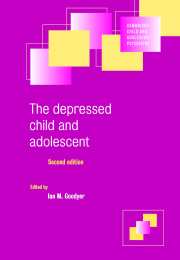Book contents
- Frontmatter
- Contents
- List of contributors
- Preface
- 1 Historical aspects of mood and its disorders in young people
- 2 The development of emotional intelligence
- 3 Developmental precursors of depression: the child and the social environment
- 4 Physiological processes and the development of childhood and adolescent depression
- 5 Childhood depression: clinical phenomenology and classification
- 6 The epidemiology of depression in children and adolescents
- 7 Family–genetic aspects of juvenile affective disorders
- 8 Life events: their nature and effects
- 9 Adolescent depression: neuroendocrine aspects
- 10 Suicidal behaviour in adolescents
- 11 Psychopharmacology of depressive states in childhood and adolescence
- 12 The psychotherapeutic management of major depressive and dysthymic disorders in childhood and adolescence: issues and prospects
- 13 Natural history of mood disorders in children and adolescents
- Index
10 - Suicidal behaviour in adolescents
Published online by Cambridge University Press: 18 December 2009
- Frontmatter
- Contents
- List of contributors
- Preface
- 1 Historical aspects of mood and its disorders in young people
- 2 The development of emotional intelligence
- 3 Developmental precursors of depression: the child and the social environment
- 4 Physiological processes and the development of childhood and adolescent depression
- 5 Childhood depression: clinical phenomenology and classification
- 6 The epidemiology of depression in children and adolescents
- 7 Family–genetic aspects of juvenile affective disorders
- 8 Life events: their nature and effects
- 9 Adolescent depression: neuroendocrine aspects
- 10 Suicidal behaviour in adolescents
- 11 Psychopharmacology of depressive states in childhood and adolescence
- 12 The psychotherapeutic management of major depressive and dysthymic disorders in childhood and adolescence: issues and prospects
- 13 Natural history of mood disorders in children and adolescents
- Index
Summary
Introduction
Discussing the topic of suicidal behaviour without discussing the context of depression is probably as precarious as is discussing depression without the possible implication of suicidality. The two phenomena share aetiology and epidemiology, and are overlapping but also distinct, since the majority of depressed adolescents do not attempt or commit suicide, and not every suicidal adolescent is depressed. Although in some other psychiatric disorders (e.g. schizophrenia, anxiety disorders, personality disorders) there is certainly an increased risk for suicide, depression clearly stands out in this respect. However, focusing on the commonalities between the aetiology and epidemiology of suicidal phenomena and depression symptomatology is perhaps less interesting than focusing on their differences, studying depressed suicidal persons and depressed nonsuicidal persons and learning from their differences. The fundamental question on which these results may shed a light is why some depressed persons attempt or commit suicide and others do not. This chapter will discuss studies that have used this approach, and other relevant studies. Before this, the concept of suicide is described and some basic rates of the various suicidal behaviours are given.
The words ‘suicide’ and ‘suicidal’ in everyday life are used to refer to self-chosen behaviour that is intended to bring about one's own death. However, of all the behaviours and experiences to which these words are attached, many are or might not be motivated by a wish to die or to do away with oneself for good. Often they are not even meant to harm oneself, but only to express or communicate complex emotions such as despair, hopelessness and anger.
Keywords
- Type
- Chapter
- Information
- The Depressed Child and Adolescent , pp. 267 - 291Publisher: Cambridge University PressPrint publication year: 2001
- 4
- Cited by



